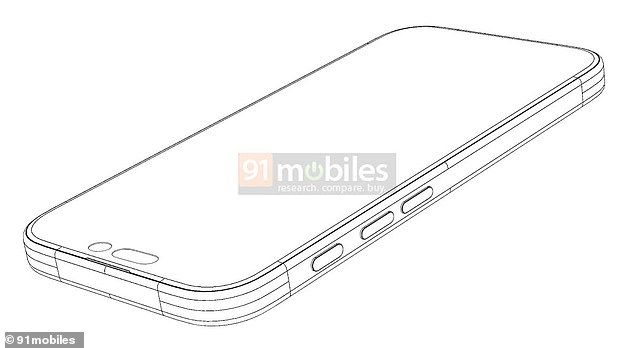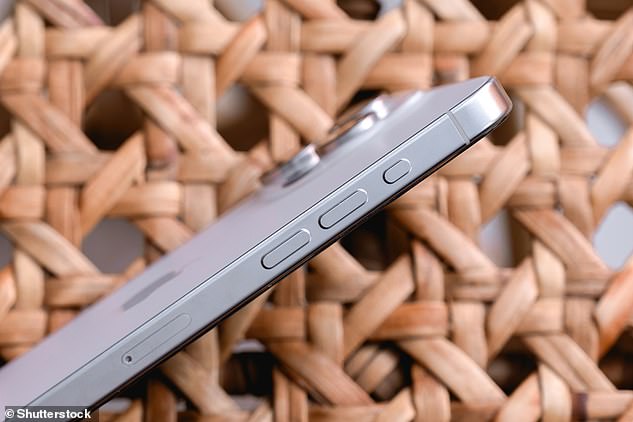iPhone 16 could have a new button, leaked renders reveal – and it’ll be an absolute gamechanger for selfie fans
Apple does its utmost to keep all details about a new smartphone strictly secret.
But a new leak gives fans the best idea yet of what the tech giant’s next iPhone will look like.
Design renders show a new button on the right side, which insiders are calling the ‘Capture Button’ – and it could be a game changer for selfie fans.
With a single press, the Capture button takes photos and launches video clips, offering users an alternative to tapping the screen.
Meanwhile, the ‘Action button’ – the small button above the volume buttons on the left – will become larger, the images suggest.
Renders obtained by 91mobiles show the upcoming iPhone 16 Pro with the new Capture button (circled in red) right below the existing power button
The new renders, obtained by 91mobilesare CAD (computer-aided design) files provided to third-party iPhone case manufacturers prior to a device’s launch.
According to the site, the Capture button is located below the usual power button location, on the edge of the phone, to the right of the screen.
“A Capture button will be present below the power button to allow better control of the camera system,” the site says.
“(It) is expected to enable features such as adjusting focus and zoom levels, in addition to being a trigger for capturing photos and videos.”
The button will feature ‘capacitive touch functionality’, meaning it will sense the touch of a human finger and respond to certain movements.
It is possible that lightly tapping the button will adjust the focus and zoom, while pressing the button will take the photo or start the video.
Ultimately, this would mean iPhone users will spend less time tapping and swiping on the screen to use the camera, capturing life’s fleeting moments much faster.

Meanwhile, the ‘Action button’ (the small button above the volume buttons on the edge of the phone on the left side of the screen) is getting bigger, 91mobiles reports. The action button first appeared on iPhone 15, but only on the Pro and Pro Max models

Like iPhone 15, the Pro and Pro Max versions of the iPhone 16 have three camera lenses on the back, in an ‘arrow’ alignment
MailOnline has contacted Apple for comment, although the tech giant does not generally comment on rumors ahead of a release.
It’s worth noting that these new renders are only for the Pro, which suggests that the two cheapest iPhone 16 models may not get the Capture button.
Like last year’s iPhone 15, the iPhone 16 is expected to come in four different versions: iPhone 16 (the standard model), iPhone 16 Plus, iPhone 16 Pro, and iPhone 16 Pro Max.
According to MacRumoursthe screen size of the two Pro models – the two most expensive options – will increase compared to the iPhone 15 equivalents.
The screen size of the Pro model will increase from 6.1 inches to 6.3 inches, while the Pro Max screen size will go from 6.7 inches to 6.9 inches, it reports.
Meanwhile, the Action Button is coming to all four iPhone 16 models, MacRumours reports.
On iPhone 15, only the two Pro models got the Action Button, while the standard and Plus models retained the mute switch from previous years.

The ‘Action button’ (the small button above the volume buttons on the edge of the phone, to the left of the screen) becomes larger
According to the latest leaked images of the iPhone 16, the tech giant is also making a major change to the camera lenses on the back of the standard iPhone 16.
The standard version of the iPhone 16 will have two camera lenses positioned vertically, and not diagonally like on the iPhone 15, according to the images.
Apple is also rumored to be introducing the ‘hole punch’ front camera, a feature typically found on Android phones.
According to some reports, iPhone 16 is expected to be the most expensive smartphone Apple has ever released in September.
While exact prices are unclear, it’s expected to outshine the iPhone 15, which starts at £799/$799 for the standard model, while the most expensive variant, the Pro Max, starts at £1,199/$1,199 and could go up to £ 1,599/$1,599. for 1TB storage.
Renders also show Apple working on the iPhone SE 4, the latest in Apple’s ‘budget’ SE smartphone line and an upgrade on the 2022 iPhone SE 3.



